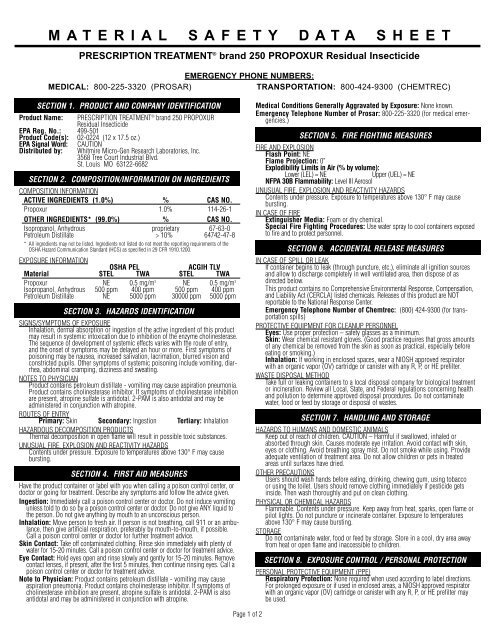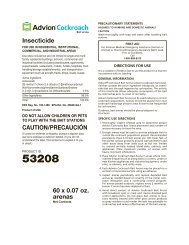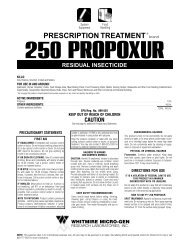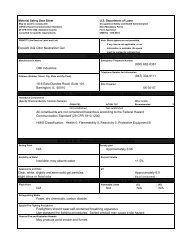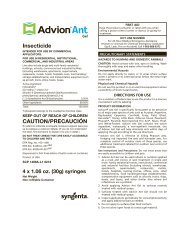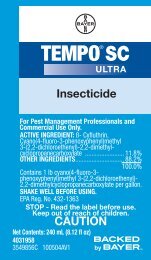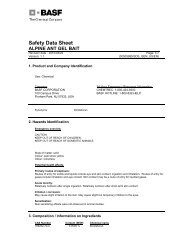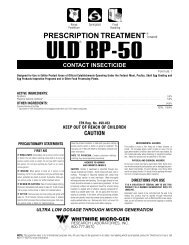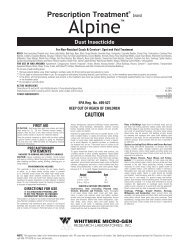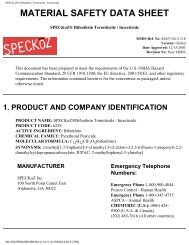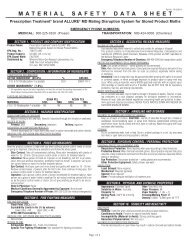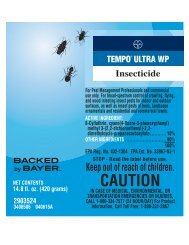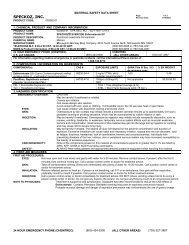PTb 250 Propoxur MSDS - Crane Pest Control
PTb 250 Propoxur MSDS - Crane Pest Control
PTb 250 Propoxur MSDS - Crane Pest Control
Create successful ePaper yourself
Turn your PDF publications into a flip-book with our unique Google optimized e-Paper software.
MATERIAL SAFETY DATA SHEETPRESCRIPTION TREATMENT ® brand <strong>250</strong> PROPOXUR Residual InsecticideEMERGENCY PHONE NUMBERS:MEDICAL: 800-225-3320 (PROSAR)TRANSPORTATION: 800-424-9300 (CHEMTREC)SECTION 1. PRODUCT AND COMPANY IDENTIFICATIONProduct Name: PRESCRIPTION TREATMENT ® brand <strong>250</strong> PROPOXURResidual InsecticideEPA Reg. No.: 499-501Product Code(s): 02-0224 (12 x 17.5 oz.)EPA Signal Word:Distributed by:CAUTIONWhitmire Micro-Gen Research Laboratories, Inc.3568 Tree Court Industrial Blvd.St. Louis MO 63122-6682SECTION 2. COMPOSITION/INFORMATION ON INGREDIENTSCOMPOSITION INFORMATIONACTIVE INGREDIENTS (1.0%) % CAS NO.<strong>Propoxur</strong> 1.0% 114-26-1OTHER INGREDIENTS* (99.0%) % CAS NO.Isopropanol, AnhydrousPetroleum Distillateproprietary> 10%67-63-064742-47-8* All ingredients may not be listed. Ingredients not listed do not meet the reporting requirements of theOSHA Hazard Communication Standard (HCS) as specified in 29 CFR 1910.1200.EXPOSURE INFORMATIONMaterialOSHA PELSTEL TWAACGIH TLVSTEL TWA<strong>Propoxur</strong> NE 0.5 mg/m 3 NE 0.5 mg/m 3Isopropanol, Anhydrous 500 ppm 400 ppm 500 ppm 400 ppmPetroleum Distillate NE 5000 ppm 30000 ppm 5000 ppmSECTION 3. HAZARDS IDENTIFICATIONSIGNS/SYMPTOMS OF EXPOSUREInhalation, dermal absorption or ingestion of the active ingredient of this productmay result in systemic intoxication due to inhibition of the enzyme cholinesterase.The sequence of development of systemic effects varies with the route of entry,and the onset of symptoms may be delayed an hour or more. First symptoms ofpoisoning may be nausea, increased salivation, lacrimation, blurred vision andconstricted pupils. Other symptoms of systemic poisoning include vomiting, diarrhea,abdominal cramping, dizziness and sweating.NOTES TO PHYSICIANProduct contains petroleum distillate - vomiting may cause aspiration pneumonia.Product contains cholinesterase inhibitor. If symptoms of cholinesterase inhibitionare present, atropine sulfate is antidotal. 2-PAM is also antidotal and may beadministered in conjunction with atropine.ROUTES OF ENTRYPrimary: Skin Secondary: Ingestion Tertiary: InhalationHAZARDOUS DECOMPOSITION PRODUCTSThermal decomposition in open flame will result in possible toxic substances.UNUSUAL FIRE, EXPLOSION AND REACTIVITY HAZARDSContents under pressure. Exposure to temperatures above 130° F may causebursting.SECTION 4. FIRST AID MEASURESHave the product container or label with you when calling a poison control center, ordoctor or going for treatment. Describe any symptoms and follow the advice given.Ingestion: Immediately call a poison control center or doctor. Do not induce vomitingunless told to do so by a poison control center or doctor. Do not give ANY liquid tothe person. Do not give anything by mouth to an unconscious person.Inhalation: Move person to fresh air. If person is not breathing, call 911 or an ambulance,then give artificial respiration, preferably by mouth-to-mouth, if possible.Call a poison control center or doctor for further treatment advice.Skin Contact: Take off contaminated clothing. Rinse skin immediately with plenty ofwater for 15-20 minutes. Call a poison control center or doctor for treatment advice.Eye Contact: Hold eyes open and rinse slowly and gently for 15-20 minutes. Removecontact lenses, if present, after the first 5 minutes, then continue rinsing eyes. Call apoison control center or doctor for treatment advice.Note to Physician: Product contains petroleum distillate - vomiting may causeaspiration pneumonia. Product contains cholinesterase inhibitor. If symptoms ofcholinesterase inhibition are present, atropine sulfate is antidotal. 2-PAM is alsoantidotal and may be administered in conjunction with atropine.Medical Conditions Generally Aggravated by Exposure: None known.Emergency Telephone Number of Prosar: 800-225-3320 (for medical emergencies.)SECTION 5. FIRE FIGHTING MEASURESFIRE AND EXPLOSIONFlash Point: NEFlame Projection: 0”Explodibility Limits in Air (% by volume):Lower (LEL) = NEUpper (UEL) = NENFPA 30B Flammability: Level III AerosolUNUSUAL FIRE, EXPLOSION AND REACTIVITY HAZARDSContents under pressure. Exposure to temperatures above 130° F may causebursting.IN CASE OF FIREExtinguisher Media: Foam or dry chemical.Special Fire Fighting Procedures: Use water spray to cool containers exposedto fire and to protect personnel.SECTION 6. ACCIDENTAL RELEASE MEASURESIN CASE OF SPILL OR LEAKIf container begins to leak (through puncture, etc.), eliminate all ignition sourcesand allow to discharge completely in well ventilated area, then dispose of asdirected below.This product contains no Comprehensive Environmental Response, Compensation,and Liability Act (CERCLA) listed chemicals. Releases of this product are NOTreportable to the National Response Center.Emergency Telephone Number of Chemtrec: (800) 424-9300 (for transportationspills)PROTECTIVE EQUIPMENT FOR CLEANUP PERSONNELEyes: Use proper protection – safety glasses as a minimum.Skin: Wear chemical resistant gloves. (Good practice requires that gross amountsof any chemical be removed from the skin as soon as practical, especially beforeeating or smoking.)Inhalation: If working in enclosed spaces, wear a NIOSH approved respiratorwith an organic vapor (OV) cartridge or canister with any R, P, or HE prefilter.WASTE DISPOSAL METHODTake full or leaking containers to a local disposal company for biological treatmentor incineration. Review all Local, State, and Federal regulations concerning healthand pollution to determine approved disposal procedures. Do not contaminatewater, food or feed by storage or disposal of wastes.SECTION 7. HANDLING AND STORAGEHAZARDS TO HUMANS AND DOMESTIC ANIMALSKeep out of reach of children. CAUTION – Harmful if swallowed, inhaled orabsorbed through skin. Causes moderate eye irritation. Avoid contact with skin,eyes or clothing. Avoid breathing spray mist. Do not smoke while using. Provideadequate ventilation of treatment area. Do not allow children or pets in treatedareas until surfaces have dried.OTHER PRECAUTIONSUsers should wash hands before eating, drinking, chewing gum, using tobaccoor using the toilet. Users should remove clothing immediately if pesticide getsinside. Then wash thoroughly and put on clean clothing.PHYSICAL OR CHEMICAL HAZARDSFlammable. Contents under pressure. Keep away from heat, sparks, open flame orpilot lights. Do not puncture or incinerate container. Exposure to temperaturesabove 130° F may cause bursting.STORAGEDo not contaminate water, food or feed by storage. Store in a cool, dry area awayfrom heat or open flame and inaccessible to children.SECTION 8. EXPOSURE CONTROL / PERSONAL PROTECTIONPERSONAL PROTECTIVE EQUIPMENT (PPE)Respiratory Protection: None required when used according to label directions.For prolonged exposure or if used in enclosed areas, a NIOSH approved respiratorwith an organic vapor (OV) cartridge or canister with any R, P, or HE prefilter maybe used.Page 1 of 2
MATERIAL SAFETY DATA SHEETProtective Gloves: Chemical resistant gloves are recommended if prolonged orrepeated skin contact is likely. (Good practice requires that gross amount of anychemical be removed from the skin as soon as practical, especially before eatingor smoking.)Eye Protection: Use proper protection – safety glasses as a minimum.Other Protective Equipment: None required.VENTILATIONLocal Exhaust: None required.Mechanical: None required.Special: None required.Other: Provide adequate ventilation of treatment area.SECTION 9. PHYSICAL AND CHEMICAL PROPERTIESAppearance: Clear liquidSolubility in Water: NEViscosity: 1.92 cps @ 23° CBoiling Point: NEpH: 7.09 @ 23° C (1% in H2O)PRESCRIPTION TREATMENT ® brand <strong>250</strong> PROPOXUR Residual InsecticideOdor: Isopropanol odorVapor Pressure: NEVapor Density: NEFreezing/Melting Point: NEDensity: 0.793 g/ml @ 20° CSECTION 10. STABILITY AND REACTIVITYREACTIVITYStability: StableConditions to Avoid: None known.Incompatibility (Material to Avoid): Avoid caustics, amines, alkanolamines,aldehydes, strong oxidizing agents and chlorinated compounds.Hazardous Polymerization: Will not occur.HAZARDOUS DECOMPOSITION PRODUCTSThermal decomposition in open flame will result in possible toxic substances.SECTION 11. TOXICOLOGICAL INFORMATIONROUTES OF ENTRYPrimary: Skin Secondary: Ingestion Tertiary: InhalationACUTE TOXICOLOGYEyes: Considered mildly irritating. Produced conjunctival irritation clearing within72 hours. No corneal opacity or iritis was observed.Skin: Not considered to be a skin sensitizer. Acute dermal toxicity (LD50) > 5,000mg/kg (rats). Primary skin irritation index = 3.8 (albino rabbits).Ingestion Acute oral toxicity (LD50) > 500 mg/kg but < 5,000 mg/kg (rats).Inhalation: Acute inhalation toxicity (LC50) > 2.11 mg/L.CHRONIC EFFECTS OF EXPOSURERepeated exposure to small amounts of the active ingredient in this product mayresult in an unexpected cholinesterase depression causing symptoms such asmalaise, weakness, and anorexia that resemble other illnesses such as influenza.Exposure to the concentration that would not have produced symptoms in a personthat was not previously exposed may produce severe symptoms ofcholinesterase inhibition in a previously exposed person.CARCINOGENICITYNeither this product nor any of its ingredients are classified as carcinogens by theNational Toxicity Program (NTP), the International Agency for Research on Cancer(IARC) or the Occupational Safety and Health Administration (OSHA). High dosesof <strong>Propoxur</strong> induced bladder cancers when fed to rats in one study. Cancer wasnot induced in several other feeding studies on rats and other animals. The implicationof these studies for humans are not known.SECTION 13. DISPOSAL CONSIDERATIONDo not contaminate water, food or feed by disposal. Dispose of container and wastesin accordance with all Federal, state and local regulations.Container Disposal: Do not puncture or incinerate! Empty container by usingthe product according to the label directions. Offer empty container for recycling,if available, or place in trash if allowed by state and local regulations. If containeris partly full, contact your local solid waste agency or call 1-800-CLEANUPfor disposal instructions.Waste Disposal: Wastes resulting from the use of this product may be disposedof on site or at an approved waste disposal facility.SECTION 14. TRANSPORT INFORMATIONSHIPMENT BY GROUND WITHIN U.S. (DOT CLASSIFICATION)Proper Shipping Description: Consumer Commodity, ORM-DPackage Marking: “Consumer Commodity ORM-D”Package Labeling: Not required.UN Packaging: Not required.SHIPMENT BY WATER (IMDG CLASSIFICATION)Proper Shipping Description: Aerosols, 2.1, UN 1950Package Marking: “Dangerous Goods in Limited Quantities of Class 2.1”Package Labeling: Not required.UN Packaging: Not required.SHIPMENT BY AIR (IATA CLASSIFICATION)Proper Shipping Description: Aerosols, 2.1, UN 1950Package Marking: “Aerosols, UN 1950, Ltd. Qty.”Package Labeling: Flammable GasUN Packaging: Not required.Other Requirements: Complete air bill with packing instruction “Y203, ERG code 10L”SECTION 15. REGULATORY INFORMATIONCERCLAThis product contains no CERCLA listed chemicals.SARA TITLE III SECTION 311/312 HAZARD CLASSThis product has been reviewed according to the EPA “Hazard Categories” promulgatedunder Section 311 and 312 of the Superfund Amendment and ReauthorizationAct of 1986 (SARA Title III) and is considered, under applicable definitions, tomeet the following categories:Acute Health HazardFlammability HazardRelease of Pressure (puncture) HazardSARA TITLE III SECTION 313 CHEMICALSThis product contains the following substances subject to the reporting requirementsof Title III of the Superfund Amendments and Reauthorization Act of 1986(SARA Title III) and/or 40 CFR Part 372:]<strong>Propoxur</strong>1.0% by weightTSCAAll components of this product are listed or excluded from listing on the US ToxicSubstance <strong>Control</strong> Act (TSCA) Chemical Substance Inventory.SECTION 16. OTHER INFORMATIONSECTION 12. ECOLOGICAL INFORMATIONNFPA HEALTH RATING INFORMATIONKEY: 4 = SevereThis product is toxic to fish and wildlife. Do not apply directly to water, or to areasHEALTH - 2 FLAMMABILITY - 4 REACTIVITY - 1 3 = Seriouswhere surface water is present or to intertidal areas below the mean high water mark.2 = ModerateDo not contaminate water by cleaning of equipment or disposal of equipment washwaters.HEALTH - 2 FLAMMABILITY - 4 REACTIVITY - 1 0 = MinimalHMIS HAZARD RATING INFORMATION1 = SlightThe information and recommendations contained herein are based upon data believed to be correct. However, no guarantee or warranty of any kind, expressed or implied, is madewith respect to the information contained herein.Questions concerning the safe handling of the product should be referred to the Whitmire Micro-Gen Customer Service Department at 800-777-8570.NA - Not Applicable Effective Date: 6/19/03NE - Not EstablishedReview Date: NAPEL - Permissible Exposure Limit WHITMIRE MICRO-GENSupersedes: 1/22/03TLV - Threshold Limit Value RESEARCH LABORATORIES, INC.Code #: 203-090STEL - Short Term Exposure Limit (15 min.) Text ID: 030616-2TWA - Time Weighted Average (8 hrs) WMG Part No.: 19-0154-1Page 2 of 2


